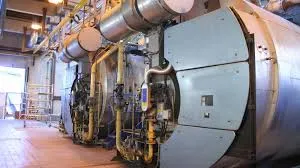What are the challenges and benefits of implementing waste heat recovery systems in plant design?
What are the challenges and benefits of implementing waste heat recovery systems in plant design?
Waste heat recovery systems (WHRS) are a way to improve the energy efficiency of industrial plants by capturing and reusing the heat that would otherwise be lost in the process. WHRS can reduce fuel consumption, greenhouse gas emissions, and operating costs, while increasing the overall performance and reliability of the plant. In this article, we will explore the challenges and benefits of implementing WHRS in plant design, and provide some practical tips and examples.
1What is waste heat recovery?
Waste heat recovery is the process of capturing and transferring the thermal energy that is generated and discarded by industrial processes, such as combustion, steam generation, or refrigeration. The recovered heat can be used for various purposes, such as preheating, power generation, or cooling. Waste heat recovery can be classified into two types: passive and active. Passive WHRS use natural convection or radiation to transfer heat, while active WHRS use mechanical devices, such as pumps, compressors, or turbines, to enhance the heat transfer.
2Why is waste heat recovery important?
Waste heat recovery is important for several reasons. First, it can improve the energy efficiency of the plant, which means less fuel consumption and lower operating costs. According to the U.S. Department of Energy, industrial waste heat accounts for about 20% of the total energy use in the U.S., and recovering just 40% of it could save about $47 billion per year. Second, it can reduce the greenhouse gas emissions and environmental impact of the plant, which can help comply with regulatory standards and improve the corporate image. Third, it can increase the overall performance and reliability of the plant, by reducing the thermal stress and wear on the equipment, and by providing additional power or cooling capacity.
Waste heat recovery boiler
3What are the challenges of waste heat recovery?
Waste heat recovery is not without challenges, such as the quality and quantity of the waste heat source, the technical and economic feasibility of the recovery system, and regulatory and institutional barriers. The waste heat source must have a sufficient temperature and flow rate to make recovery feasible and economical, while also being compatible with existing plant layout and equipment. The recovery system must have a reasonable payback period and return on investment, while also requiring permits, approvals, or incentives from relevant authorities. Additionally, waste heat recovery may face competition from renewable energy or energy efficiency measures.
4How to design a waste heat recovery system?
The design of a waste heat recovery system is based on several factors, such as the type and characteristics of the waste heat source, the intended use and demand of the recovered heat, the available space and resources, and the economic and environmental objectives. Generally, this involves conducting a waste heat assessment to identify and quantify the waste heat sources and sinks in the plant. Then, selecting a waste heat recovery technology that is suitable for recovery, such as heat exchangers or thermoelectric generators. After that, optimizing the system by designing and sizing its components and parameters. Finally, implementing and monitoring the system by installing it, ensuring its proper operation and maintenance, measuring its actual performance and benefits, and identifying potential improvements or issues.
5What are some examples of waste heat recovery systems?
Waste heat recovery systems are widely used in many industrial sectors, such as power generation, chemical, metal, cement, food, and textile. For instance, a combined heat and power (CHP) system uses a gas turbine or an engine to generate electricity, while recovering the exhaust heat to produce steam or hot water for heating or cooling purposes. A steam turbine utilizes the high-pressure steam from a boiler or a process to generate electricity, while recovering the low-pressure steam for process heating or cogeneration. A regenerative burner uses a ceramic heat exchanger to preheat the combustion air with the exhaust gas from a furnace or a kiln, allowing for reduced fuel consumption and emissions. Refrigeration systems utilize an absorption chiller to produce chilled water with the waste heat from a process or a CHP system for air conditioning or process cooling. Heat pumps upgrade low-grade waste heat from a process or a cooling tower to a higher temperature level with the use of a compressor, providing hot water or steam for heating or drying purposes.
-
Top Electric Steam Boiler Manufacturers - High Efficiency SolutionsNewsJul.30,2025
-
Top Electric Steam Boiler Manufacturers – Efficient Industrial SolutionsNewsJul.29,2025
-
Top Electric Steam Boiler Manufacturers | Reliable Industrial SolutionsNewsJul.29,2025
-
OEM Steam Boiler Solutions for Custom Needs | High Efficiency & VersatilityNewsJul.29,2025
-
High-Efficiency Thermal Oil Boiler for Industrial Heating SolutionsNewsJul.29,2025
-
Top Electric Steam Boiler Manufacturers for Industrial EfficiencyNewsJul.28,2025


